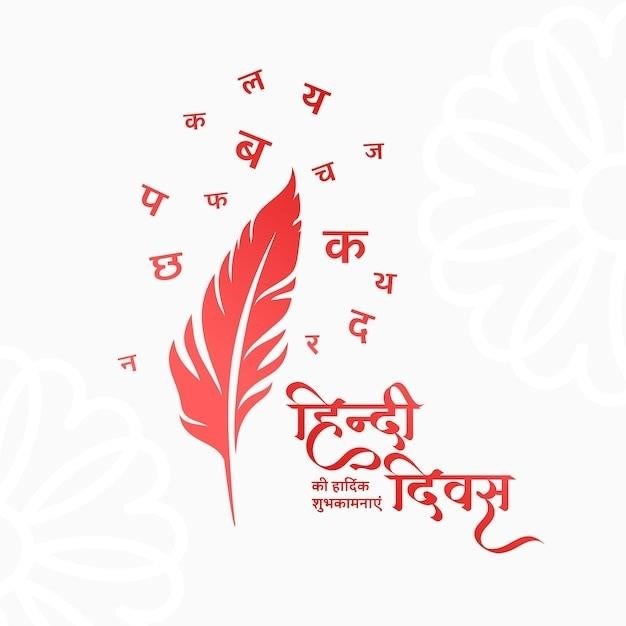
Atharva Veda PDF⁚ A Comprehensive Guide
This guide explores the availability, versions, and legal aspects of Atharva Veda PDFs․ It delves into accessing reliable sources, ethical downloading practices, and the Veda’s rich content, themes, and historical significance within Vedic literature․ Discover its profound impact and explore its unique place among ancient scriptures․
Availability of Atharva Veda PDFs Online
Numerous websites offer Atharva Veda PDFs, presenting both challenges and opportunities for researchers and enthusiasts․ The ease of access is a double-edged sword; while readily available translations and versions (including those in Hindi) simplify study, the lack of centralized quality control raises concerns․ Some PDFs are complete Samhitas, others offer selections, translations, or commentaries․ The quality varies considerably, with some offering high-resolution scans of ancient texts, while others might be low-quality scans or typed transcriptions with potential inaccuracies․ Finding a reliable PDF requires careful evaluation of the source’s reputation and the PDF’s presentation․
The sheer volume of available resources, ranging from complete Samhitas to individual hymns and translations, reflects the Atharva Veda’s enduring appeal and the ongoing scholarly interest in this ancient text․ However, this abundance necessitates a discerning approach when selecting a PDF for study, ensuring the chosen resource aligns with the user’s needs and research standards․
Different Versions and Translations Available
The Atharva Veda’s online presence showcases a diversity of versions and translations, catering to various needs and levels of expertise․ You’ll find complete Samhita texts in Sanskrit, alongside transliterations designed to aid pronunciation and comprehension for those unfamiliar with the Devanagari script․ Multiple English translations exist, each offering unique interpretations and stylistic choices, reflecting the translator’s understanding and perspective․ Some translations prioritize literal accuracy, while others strive for a more fluid and accessible rendering․ Additionally, some PDFs might include commentaries or explanatory notes, enriching the reading experience and providing valuable context․
Beyond English, translations in other languages may be available, expanding access to a wider audience․ The availability of different versions reflects the text’s complex structure and the ongoing scholarly debate surrounding its interpretation․ Choosing the appropriate version depends on the reader’s background, purpose, and desired level of detail; a beginner might prefer a simplified translation, while a scholar might favor a version with extensive annotations and critical apparatus․ This variety ensures that the Atharva Veda remains accessible to a broad range of individuals․
Accessing Atharva Veda PDFs⁚ Sources and Platforms
Locating reliable Atharva Veda PDFs requires navigating various online resources․ Academic websites of universities and research institutions often host digitized versions of scholarly editions, sometimes offering free access or requiring subscriptions․ Digital libraries, such as the Internet Archive, may contain scanned copies of older publications, offering a valuable historical perspective․ These sources generally provide high-quality scans, ensuring accurate representation of the original texts․ However, these versions might lack the detailed annotations or translations found in more specialized scholarly editions․
Furthermore, websites dedicated to religious texts or Indic studies frequently provide PDFs of the Atharva Veda, sometimes alongside commentaries and translations․ Caution is advised when using less established sources; verification of the text’s authenticity and accuracy is crucial․ Always cross-reference information from multiple sources to ensure reliability․ While free downloads are readily available, be mindful of copyright restrictions and ethical considerations; respecting intellectual property rights is paramount when accessing and utilizing these invaluable resources․
Legal and Ethical Considerations of Downloading PDFs
Downloading Atharva Veda PDFs necessitates careful consideration of copyright and intellectual property rights․ Many online versions are protected by copyright, restricting unauthorized distribution or modification․ Downloading and sharing copyrighted material without permission is illegal and unethical․ Respect for the intellectual property of authors, translators, and publishers is crucial․ Public domain texts, however, are free from copyright restrictions and can be legally accessed and shared․ Determining a text’s copyright status requires careful examination of its publication details and associated metadata․
Beyond legal concerns, ethical considerations are paramount․ The Atharva Veda holds deep spiritual and cultural significance․ Respectful engagement involves acknowledging the text’s sacred nature and avoiding any disrespectful or exploitative use․ Downloading PDFs should be motivated by genuine scholarly inquiry, spiritual study, or personal enrichment, not for commercial gain or malicious purposes․ Responsible use includes proper attribution and citation whenever the downloaded material is used or referenced in any work․ Always prioritize ethical and legal behavior when handling any sacred text, particularly one with such historical significance as the Atharva Veda․
Content and Structure of the Atharva Veda
The Atharva Veda, unlike the other Vedas primarily focused on ritual and praise, contains a diverse collection of spells, charms, prayers, and hymns․ Its content reflects a wide range of human concerns, encompassing health, wealth, protection from harm, and even matters of love and relationships․ Many spells aim to counteract curses, diseases, or negative influences․ Alongside these practical applications, the Atharva Veda also includes philosophical and theological reflections, showcasing a nuanced understanding of the cosmos and human existence․ This unique blend of practical magic and spiritual insight sets it apart from its Vedic counterparts․
Structurally, the Atharva Veda is organized into books (kāṇḍas) and hymns (sūktas)․ Each hymn comprises a series of verses (mantras) that are often intricately structured, employing specific meters and linguistic devices․ The collection’s organization isn’t always systematic, reflecting its likely organic growth over time․ Unlike the Rig Veda’s more structured arrangement around deities and their attributes, the Atharva Veda’s organization is thematic, with hymns grouped according to their intended purpose or subject matter․ This organizational structure underscores the Veda’s pragmatic and diverse approach to its subject matter․
Key Themes and Concepts Explored in the Atharva Veda
The Atharva Veda explores a rich tapestry of themes and concepts, significantly diverging from the primarily ritualistic focus of the other Vedas․ Central to its concerns is the well-being of individuals and communities․ This manifests in numerous spells and charms designed to protect against illness, injury, and malevolent forces․ The power of speech and the potency of mantras are recurring motifs, reflecting a belief in the ability of carefully crafted words to influence the world․ Themes of fertility, prosperity, and successful harvests are also prominent, showcasing the Veda’s close connection to agricultural life․
Beyond the practical, the Atharva Veda delves into deeper philosophical questions․ Concepts of life and death, the nature of reality, and the relationship between humans and the cosmos are subtly explored within its hymns․ While not always explicitly articulated, these themes emerge through metaphors, similes, and the very act of invoking supernatural forces to shape human destiny․ This blend of practical magic and philosophical undercurrents makes the Atharva Veda a complex and fascinating text․

The Atharva Veda’s Place within Vedic Literature
Unlike the Rig, Sama, and Yajur Vedas, which primarily focus on hymns to deities, rituals, and philosophical inquiries, the Atharva Veda occupies a unique position․ Often considered the fourth Veda, it’s characterized by its practical and applied nature․ While containing some hymns similar to the Rig Veda, its core content distinguishes it significantly․ The Atharva Veda’s focus on spells, charms, and incantations for everyday life sets it apart, dealing with issues of health, wealth, and protection from harm․ This focus on the mundane and the practical contrasts with the more transcendent concerns of other Vedic texts․
Despite its seemingly different approach, the Atharva Veda is intrinsically linked to the broader Vedic tradition․ Its inclusion within the canonical four Vedas highlights its importance and its contribution to the larger body of Vedic knowledge․ The presence of philosophical and theological elements within its verses suggests a connection to the deeper spiritual and metaphysical inquiries of other Vedic texts․ Studying the Atharva Veda therefore provides a more complete understanding of the diversity and complexity of the Vedic worldview․
Significance and Impact of the Atharva Veda

The Atharva Veda holds immense significance for understanding ancient Indian society and culture․ Its practical focus on everyday life provides invaluable insights into the concerns and beliefs of the Vedic people․ The spells and charms reveal their anxieties about illness, misfortune, and conflict, showcasing their attempts to control and influence their world․ The inclusion of mantras and prayers offers a window into their spiritual practices and beliefs, revealing a complex interplay of religious ritual and practical concerns․ The Veda’s enduring relevance lies in its depiction of the human condition across millennia, highlighting the timeless human desire for health, prosperity, and protection․
The Atharva Veda’s impact extends beyond its historical and anthropological value․ Its rich collection of mantras and prayers continues to influence religious and spiritual practices in modern India․ The hymns are still recited and chanted during various ceremonies and rituals, demonstrating their continued relevance to Hindu religious traditions․ Furthermore, its exploration of the relationship between humans and the natural world provides insights into ancient ecological perspectives․ By examining the Atharva Veda, we gain a deeper understanding of the continuity and evolution of spiritual and cultural practices in India․